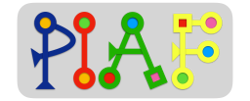“Hello Ruby” book series
http://www.helloruby.com/books
Short description
The “Hello Ruby” book series was produced by Linda Liukas, a programmer, storyteller and illustrator from Helsinki, Finland. It includes “Adventures in Coding”, “Journey Inside the Computer”, and “Expedition to the Internet”. Through the means of age-appropriate stories, these books try to generate young children’s interest in Computational Thinking and to convey certain fundamental ideas in an engaging and fun way. The hero of the 3 books is a little girl, Ruby.
“Our aim is to create, promote and evaluate exceptional educational content on computational thinking for 4 -to 10-year-old children across different channels. These include things like the ability to decompose a problem, spot patterns, think algorithmically, debug problems and work together.”
Material and technical aspects
Currently, the series is composed of 3 books: “Adventures in Coding”, “Journey Inside the Computer”, and “Expedition to the Internet”. They have been translated into 22 languages! There are additional online resources that can be used to learn more about the topics addressed in the books. There are many playful learning activities (http://www.helloruby.com/play) and a lot of teaching resources (http://www.helloruby.com/loveletters) that you can freely use and/or download to use at home or in the classroom. The printed books cost about 14€ – 17€ per book. Digital versions are also available.
Content
The books were written and illustrated by Linda Liukas is a programmer, storyteller and illustrator from Helsinki, Finland. She is “a central figure in the world of programming and has worked on edutech already before it was called that. Linda is a Codecademy alumni and the founder of Rails Girls, a global phenomenon teaching the basics of programming for young women all over the world. Having never really outgrown fairytales, Linda sees the web as a maze of stories and wants to hear more diverse voices in that world”.
When she made the first book she wanted to “create, promote and evaluate exceptional educational content on computational thinking for 4- to 10-year-old children across different channels”. The focus here lies on “the ability to decompose a problem, spot patterns, think algorithmically, debug problems and work together”. The necessity of creativity in the field of computational thinking is also an important topic throughout the book series. Different characters in the books are named after operating systems, software tools and the likes. The main hero of the books is a young girl to show children (girls and boys alike) that computers and programming are also accessible for girls.
Pedagogical aspects
From a pedagogical point of view, this learning resource uses storytelling as a fun and implicit learning experience. It is supposed to create opportunities to “learn about programming logic and culture before showing children a single screen”. Teachers can indeed use the books to introduce even relatively young children to the world of computers in age-appropriate ways that they are used to from their normal teaching practices in early childhood education. The stories from the books can be used as a springboard for other more active learning activities, like oral storytelling, drawing, role play. Teachers can also download additional worksheets for kids to work on, in playful and creative ways. The materials (books and additional resources) are indeed meant to be used by “kids, parents and educators to learn to understand programming in a fun and creative way”. Learning is supposed to happen through listening to stories, discussion, creation, exploration, and experimentation.
Conclusion
Overall, this book series allows to introduce certain basics of programming logic and culture to young children without using any electricity, computer, or screen. It can appeal to teachers because it closely resembles other storybooks that they use to inspire interest in children and to convey first simple ideas about a content knowledge domain. The different additional learning materials offer a plethora of opportunities to engage children’s minds and bodies in hands-on, creative, and collaborative learning activities. A highly recommendable pedagogical resource, especially for teachers in early childhood education!

